We’ve all encountered baijiu somewhere – perhaps toasting at a wedding banquet, sealing a new business deal, or greeting the sunrise with the lads outside of a 7-Eleven. But with China becoming increasingly international, the question remains whether the Middle Kingdom’s national liquor will find global recognition or fade into obscurity. Big baijiu is placing its bets on where and how to stay relevant in a rapidly changing market.
Despite seeing massive growth in recent years, the baijiu industry is at a crossroads. Baijiu’s major consumer group is over 60 years old, while the younger generation of Chinese drinkers has shown less affection to the spirit – viewing it as their father’s or grandfather’s drink of choice. Below, we learn how baijiu’s modernity can put it on the world map.
Top-heavy Drinkers
It’s a Tuesday night, and we find ourselves on the third floor of Guangzhou’s new 90s-style F&B mecca Super Wenheyou. The restaurant slash bar arena is probably best described as a night market with boozy characteristics.
It’s here that we step into Sanyou, a baijiu-focused watering hole with brick walls, black tiles, rich wood and a red lacquered cabinet that gives it a distinct stamp of China.
At the helm of the brooding barroom is Head Bartender and Manager Jackwing Yao – the person who all the baijiu enthusiasts and experts have told us we need to see.
She’s recently returned to Guangdong’s capital from a baijiu cocktail event at the W Hotel Chengdu. A modern cocktail-ready brand of baijiu, Banhai, or ‘Half Seas Over,’ flew her out as the ‘startender’ for the party. Artisanal cocktails are just one way that the baijiu industry is reinventing itself for the next generation of drinkers.
We give Sanyou’s baijiu negroni a try, served in a heavy iron teapot with fresh citrus and herb garnishes blooming out of the top. It’s made with dongjiu, a Guizhou medicinal baijiu sealed in a clay pot for 10 years with 130 traditional Chinese medicine (TCM) botanicals.
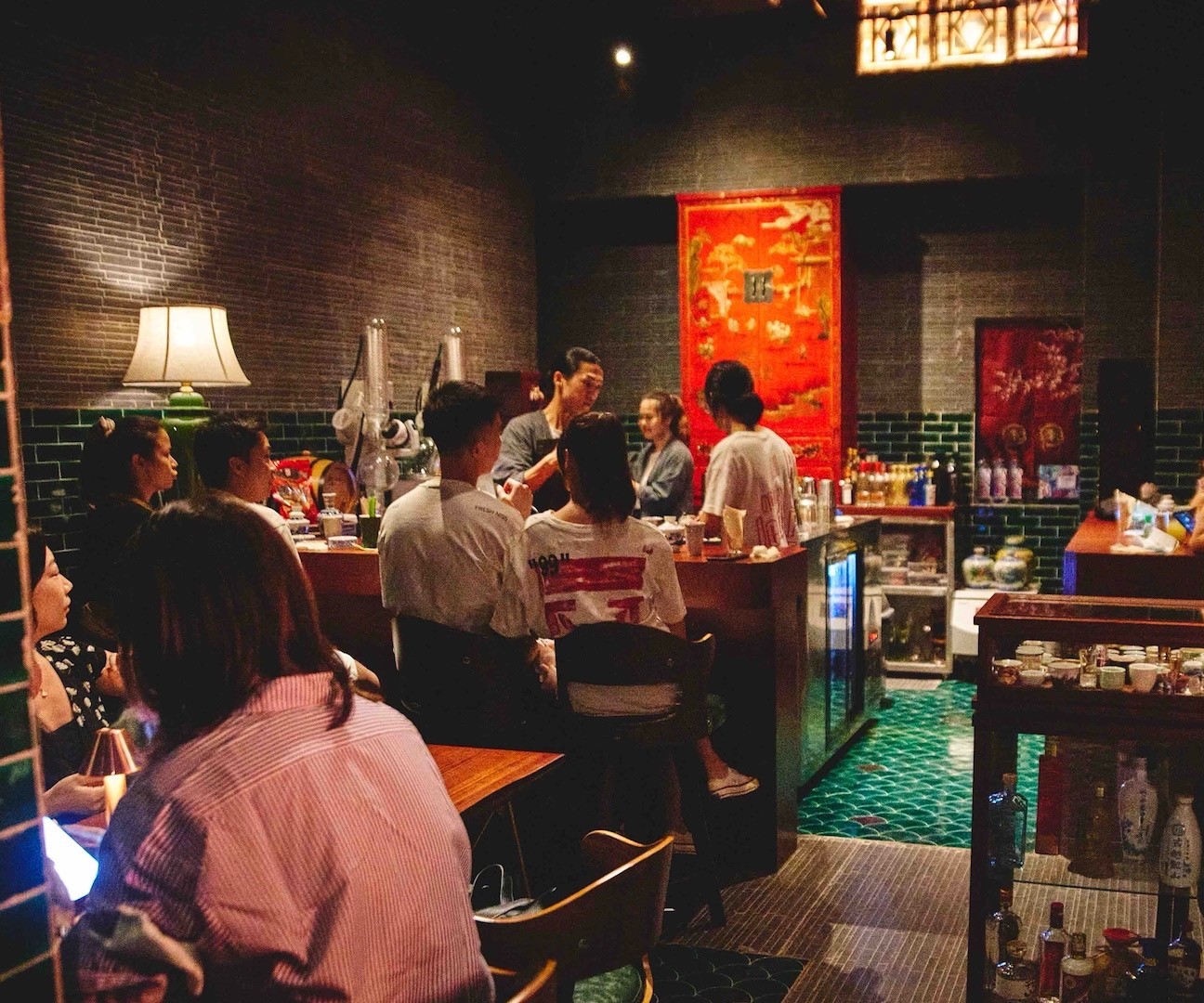 The bar at Sanyou. Image via Hope Group
The bar at Sanyou. Image via Hope Group
Poured over a monstrous ice cube, the fresh, floral and herbaceous layers are soothing yet explosive. The cocktail is world-class, and we understand immediately why a baijiu bar like Sanyou is inspiring the game.
Baijiu is the most widely produced spirit in the world, but beyond the borders of China, it is either completely unknown or painfully misunderstood. Outside China, the world’s most valuable alcohol conglomerates (AB InBev, Diageo, Pernod Ricard and Constellation) have a combined value of USD296 billion as of March 2021. However, Forbes reported that China’s two top distillers, Kweichow Moutai and Wuliangye, had surged in value to an astonishing USD517.2 billion.
READ MORE: The Established and the Up-and-Comers in the Baijiu-verse
Baijiu has a deeply rooted cultural significance, for example at government banquets, since becoming China’s national drink in 1949. In 1972, Chairman Mao served baijiu to Richard Nixon to mark the first time a US president visited the PRC.
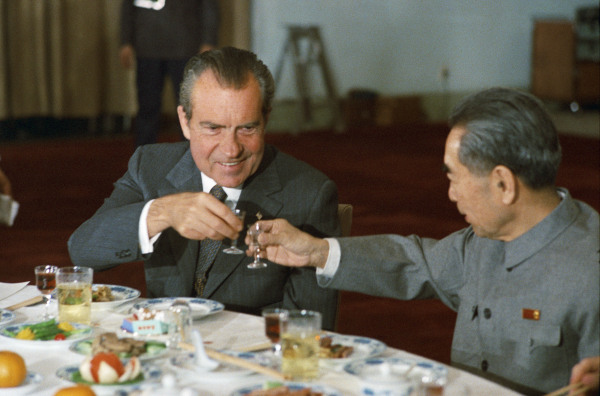
Former US President Richard Nixon and Chinese Premier Zhou Enlai knocking back a couple of shots of baijiu. Image via @newalbanian/Twitter
Drinking baijiu in professional settings requires a deep understanding of the ‘toasting’ ritual, where the most senior or distinguished guests drink first, with the undersized goblets drank in a descending hierarchy.
An even more classical gesture is to lower one’s glass and face below that of your superior, or the recipient of the toast, as a show of respect.
WATCH: Everything You Need to Know About China's Drinking Culture
Research shows that Chinese consumers in the 20- to 35-year-old category are most likely to buy imported wine and liquor. Yao tells us, “Many young people don’t like baijiu because it’s very strong and hard to drink. There are many different light-aroma and rice-aroma baijiu that are easy to drink, but young people don’t know. They only know Moutai, Luzhou Laojiao and things like that.”
In response, major baijiu brands are branching out and changing the recipe to attract younger customers in China. The industry is also making inroads into the global market; converting one bartender at a time.
Baijiu Beginnings
Introducing baijiu to the rest of the world is not going to be easy. The clear spirit is preceded by sweeping assumptions and misguided monikers like ‘liquid razor blades’ or ‘rice wine.’ Baijiu is not wine but rather a meticulously crafted alcohol extracted from the dry or semi-dry fermentation of grains. Also, most baijiu contains no rice at all, as this represents but one specific subcategory, of which there are at least a dozen.
The main four categories, aptly dubbed ‘aromas,’ are strong aroma, light aroma, sauce aroma and rice aroma. Most baijiu is made from sorghum, a grain that could be easily mistaken for quinoa.
One of the defining characteristics of Chinese alcohol is qu, which refers to the agent of fermentation.
Recipes for qu are closely guarded and vary wildly, but can be lumped into big qu and small qu. Big qu is a large brick of moist grain paste that is aged for months to develop a colony of bacteria, fungus and other microorganisms.
Small qu is a paste of ground rice formed into small balls and coated in previously fermented small qu for use as a fermenting agent about five days later.
The invention of qu is at least a thousand years old, but China’s tale of alcohol goes back much, much further.
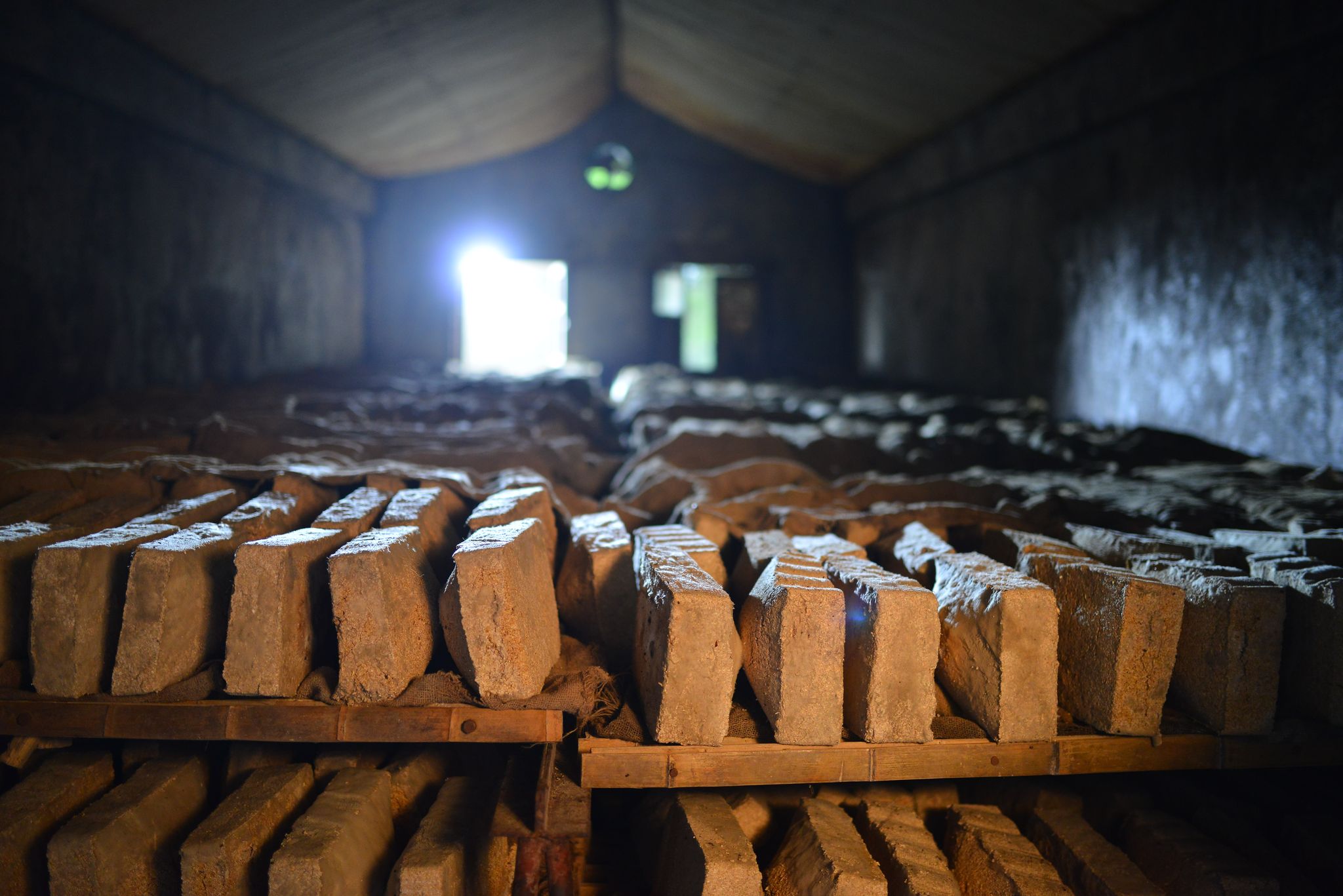
Bricks of big qu being aged for bacterial colonization. Image via Ming River Baijiu
In the early 2000s, archeochemists from the University of Pennsylvania were analyzing samples from a neolithic village, Jiahu, along the Yellow River in Northern China’s Henan province. Chemical analyses of ancient pottery revealed that the Jiahu villagers were busy making rice, fruit and honey wine a whopping 9,000 years ago.
The proof is provided, but the recorded historical origins of alcohol in China are hazy, as are most stories involving booze. Some researchers cite historical documents, which attribute one of the original methods to Yi Di, the wife of King Yu, around 2100 BCE.
According to Herbert Allen Giles, a British sinologist and diplomat stationed in China at the end of the 19th Century, a Chinese statesman named Chang Chi’en is said to have brought grapes and the art of wine-making to China from the Greek Kingdom of Bactria in 126 BCE.
The ritualistic consumption of baijiu is steeped in Confucian values.
In book 2 of The Analects of Confucius, compiled by his disciples after his death in 479 BCE, Confucius refers to the ritual of serving wine and food to the old before the young. He also often warned not to overindulge in drinking, especially at a funeral.
WATCH: Woman Downs 2 Baijiu Bottles, Floats Down Yangtze
Lao Tzu, the father of Taoism, appears to have had a more relaxed opinion of intoxication. Chuang Tzu, a student of Lao Tzu, expresses this wonderfully in the following quote translated by Giles: “A drunken man who falls out of a cart, though he may suffer, does not die. His bones are the same as other people’s; but he meets his accident in a different way. […] Ideas of life, death, fear, etc., cannot penetrate his breast; and so he does not suffer from contact with objective existences. And if such security is to be got from wine, how much more is it to be got from Tao?”
“A drunken man who falls out of a cart, though he may suffer, does not die”
The Tang Dynasty (618-906 CE) is often considered to have been a golden age for Chinese culture, and it was in this period where we encounter Li Bai. Somewhat the Hemingway of his time, Li Bai is China’s favorite drunk as his poems romanticize days spent frolicking between naps, drunk off what would then have been huangjiu or actual rice wine.
Here’s a sample of the poet’s love for drinking in ‘Waking from Drunkenness on a Spring Day’ (translated by Arthur Waley):
“Moved by its song I soon began to sigh, and, as wine was there, I filled my own cup. Wildly singing I waited for the moon to rise; when my song was over, all my senses had gone.”
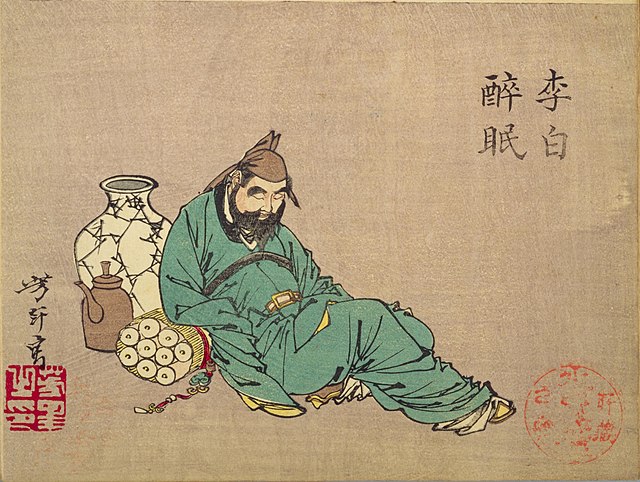
Li Bai in drunken repose. Art by Tsukioka Yoshitoshi (1839-1892), the last of the Japanese woodblock print masters. Image via Wikimedia
Not Your Grandpa’s Baijiu
The colorful history of baijiu has failed to preserve its relevance among China’s young adults. Baijiu has always been a staple of Chinese dining, and the spirit is said to pair best with the regional cuisine of its place of origin.
One would be remiss not to serve baijiu at a wedding, and restaurants are sure to have at least a few brands on hand. However, one place in Chinese society where baijiu is notably absent is in the club.
Nightclubs are very much a Western import to China, having emerged around the foreign concessions in the early 20th century – a time when Shanghai was referred to as the ‘Paris of the East.’
We asked Alexandre Lacroix to share some insight from his many years in the Guangzhou nightclub scene. Lacroix is the CEO of IALVA, which now specializes in brand consultation and promotion, but was once Guangzhou’s largest ‘filler’ agency (filling clubs with guests by giving away drinks).
“Having foreign alcohol is much fancier and [clubs] can put a high price on it”
He told That’s that he has rarely seen baijiu in nightclubs. Instead, whiskey, vodka and sparkling wine are the most sought-after libations in Chinese clubs.
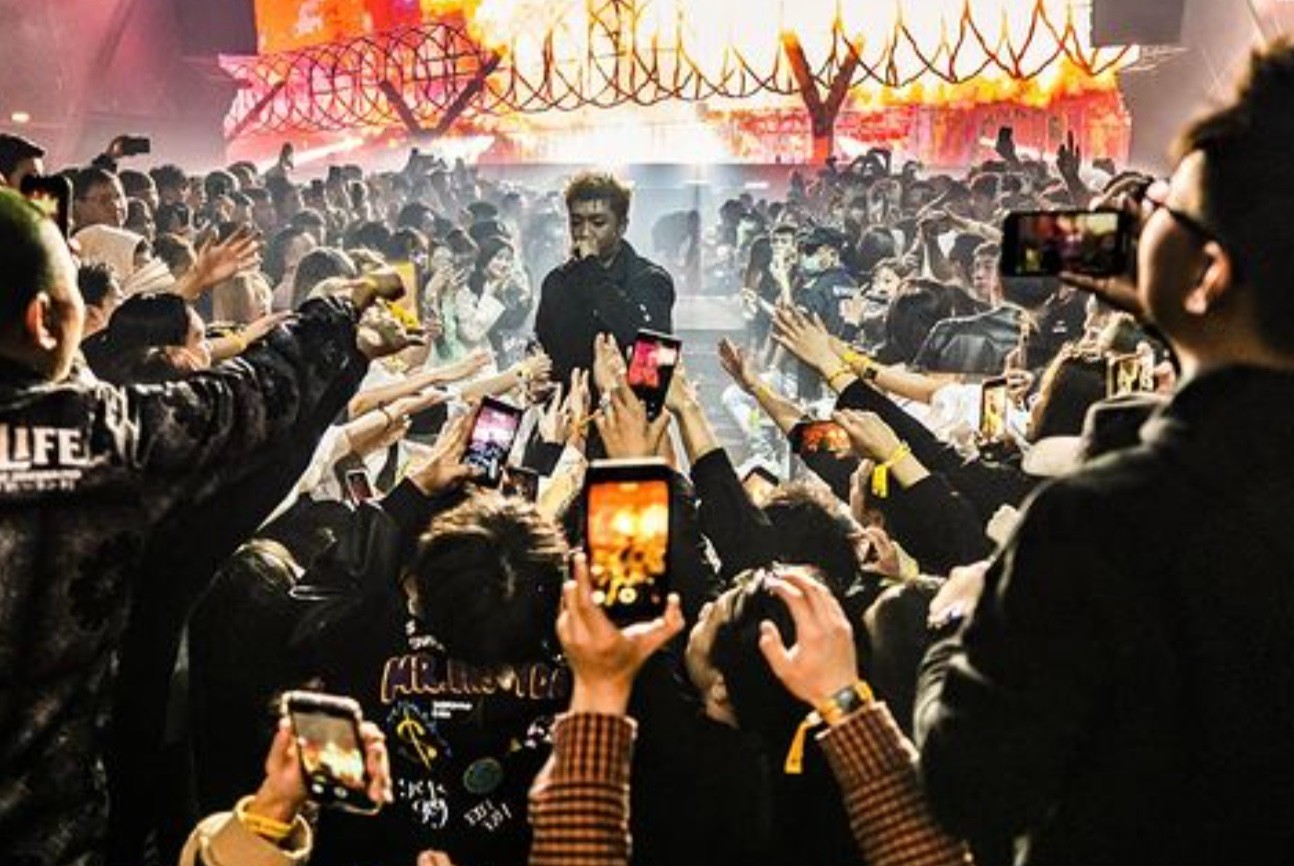
Chinese rap star KeyNG performing at Space Nanjing, October 30, 2020. Image via @spaceplus_china/Instagram
Lacroix makes the argument that baijiu doesn’t fit the clubbing mold because it’s either too expensive or too cheap for clubgoers. He adds that “having foreign alcohol is much fancier and [clubs] can put a high price on it.”
According to an article published by Spirits Selection Concours Mondial de Bruxelles, China imported USD4 billion worth of spirits in 2018. French brandy dominated, including high-priced cognac and Armagnac, and amounted to nearly half of the 83 million liters of liquor that flowed over the border.
Meanwhile, millennials are spending and drinking the most when it comes to alcohol in China, and baijiu brands are tweaking traditional recipes to attract the younger crowd. As many baijiu brands push the 50% ABV threshold, less potent baijiu and fruit infusions are tactics currently being put to the test.
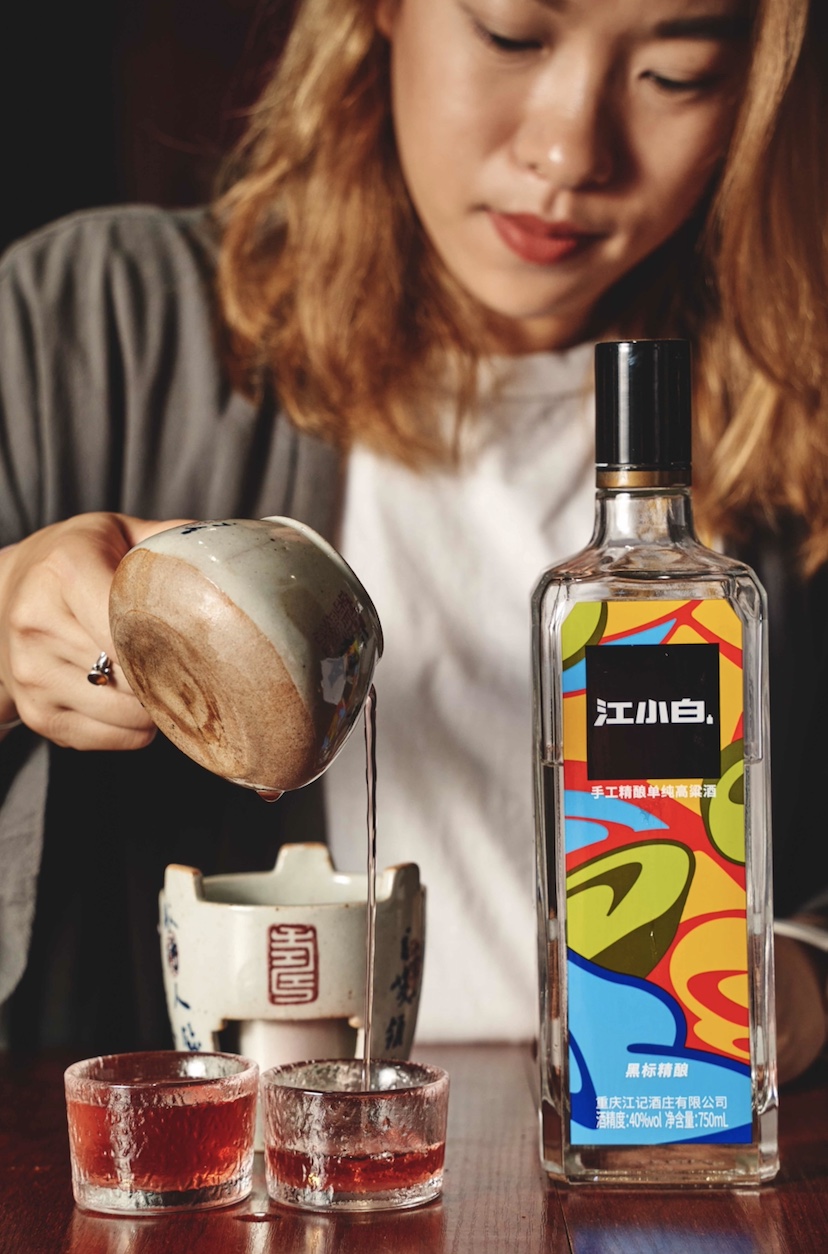
Jackwing Yao mixing up some magic with Jiangxiaobai. Image via Sanyou
Jiangxiaobai, headquartered in Chongqing, has been targeting the lower age bracket for years with considerable success – the company was valued at USD1.6 billion at the end of summer 2020.
Easily recognizable by its anime-boy logo, the brand has carefully cultivated a ‘youthful’ image by hosting dance and graffiti competitions as well as the YOLO music festival from 2016 to 2018. They have collaborated with Japanese candy-coated breadstick brand Pocky to make a baijiu-flavored confection and work with other brands to increase exposure.
READ MORE: We Tried Baijiu Flavored Pocky and it's Surprisingly Good
As for the big-time baijiu distillers like Moutai, they’re starting to invest in the younger generations.
Tang Yifan, Manager of Promotions for Kweichow Moutai in Guangzhou, directed us to a hip music video that Moutai released just before the Spring Festival titled ‘Oh, It’s Moutai.’
The video features three young non-Chinese nationals dancing around the streets of Moutai town in Guizhou, rapping about their love of Chinese liquor.
WATCH: Famous Baijiu Brand Moutai Releases Cringeworthy Rap Song
“The way for baijiu to open up to young people and foreign markets is to make culture the output,” Tang tells us. She believes combining elements of popular culture, like hip hop, will make the brand itself more appealing. Jiangxiaobai also sponsored a music video with Chinese rap pioneer GAI back in 2018. Watch ‘The Flow of Jiang Hu’ music video below (VPN off):
Another angle being explored by big baijiu is the world of craft cocktails. Yao from Sanyou tells us one label, Baitiao, was developed by Luzhou Laojiao for the specific purpose of mixing drinks.
In 2017, Baitiao organized a baijiu cocktail competition held at the China International Import Expo. Kweichow Moutai also hosted a baijiu cocktail competition in Hainan last November, to which Yao was summoned as a judge.
“The way for baijiu to open up to young people and foreign markets is to make culture the output”
Yao’s previous venture, Spin, sadly succumbed to the pandemic, but she was scooped up by the great minds behind award-winning cocktail bar Hope & Sesame. Yao explains, “after me and my team left [Spin], the owners of Hope & Sesame, Andrew and Bastien, looked for me because they wanted to open a baijiu cocktail bar. I think, for me, it was a big challenge. I had made baijiu cocktails before, but I didn’t study it too deeply. I have been bartending for more than 10 years so I think it is very interesting.”
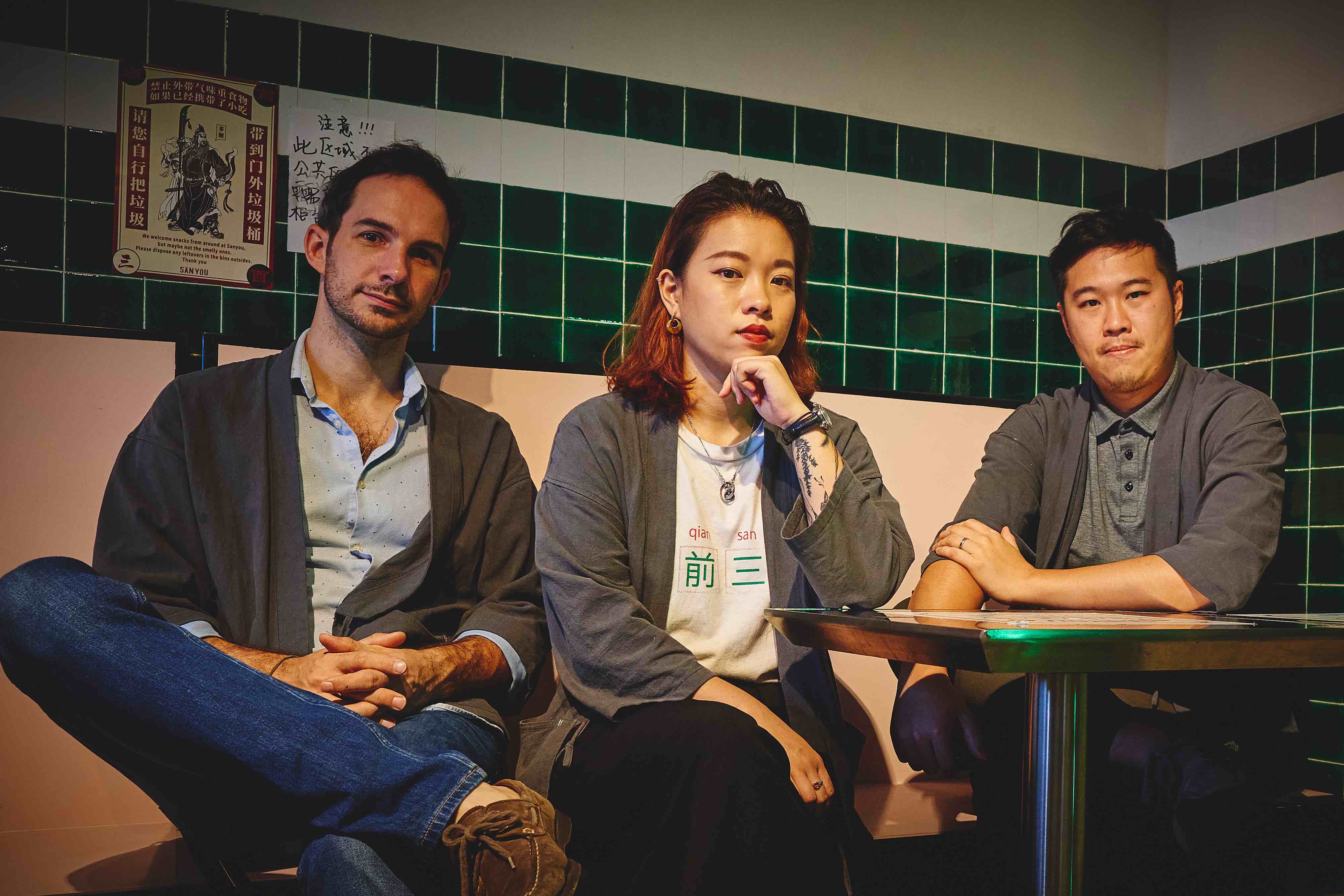
Bastien Ciocca (left) and Andrew Ho (right) from Hope & Sesame teamed up with Yao (middle) to create Sanyou. Image via Hope Group
Although some baijiu brands are betting on light aroma for the cocktail scene, her bar program is curated to include all 12 classifications of baijiu and showcase their unique flavors. The tasting notes for different baijiu are comically diverse, ranging from ‘freshly sharpened pencil’ to ‘candied banana.’ To a knowledgeable and creative bartender like Yao, baijiu is full of possibilities.
Sanyou’s most popular libation is the Moutai Milk Punch – cherry and chocolate compliment the creaminess of the baijiu, with a dash of red pepper bitters.
Yao says cocktails are gaining popularity in China but admits that expats make up a big part of the Sanyou clientele. A handful of Westerners who developed a love of baijiu while living in China are taking it global.
Baijiu Diplomacy
In Shanghai, Australian native James Gillespie and American RJ Steiner officially launched their bartender baijiu in April.
The brand, 白8 (pronounced baiba), infuses eight different Chinese botanicals into the spirit.
After three years of rigorous experimentation, the pair selected a light aroma baijiu as the canvas for their carefully selected blend of ingredients – Sichuan peppercorns, shiitake mushrooms, green tea and coriander, to name a few.
READ MORE: Viagra found in 5,000 bottles of baijiu in Liuzhou
Gillespie tells That’s, “We wanted to create a baijiu that younger, cosmopolitan Chinese could not only identify with but also enjoy outside of where and how baijiu was traditionally consumed – at banquets and in restaurants.”
Each botanical was distilled separately to build a library of over 100 samples. Despite their TCM benefits, the ingredients were chosen and blended with mixology in mind. The pair envision baijiu following in the footsteps of gin. “In the West, we are seeing something similar with gin, where consumers want more than just a ‘London Dry’ Gin that their mothers and fathers drank – which we believe has led to the explosion of ‘craft’ gins in the market currently,” says Gillespie.

The secret blend of herbs and spices. Image via 白8
One long-time baijiu expert on the scene is Jim Boyce, a Canadian who currently resides in Beijing. Boyce moved to China in 2004 to work as the communications director for a chamber of commerce.
His interest in the cocktail and wine scene led him to start the Beijing Boyce newsletter in 2005 and then the Grape Wall of China blog in 2007.
However, his first encounter with baijiu happened earlier in 1999 when he traveled to Inner Mongolia and spent a few nights in a yurt. He noticed a couple of security guards laughing and sending explosions of baijiu up from the fire pit. Naturally, they offered Boyce a toast and he recounts thinking, “If it explodes into flame on a fire, then it’s probably going to start a nice fire in my belly.”
Boyce would later go on to start World Baijiu Day (WBD) in 2015 – a self-described passion project that’s slowly gaining steam. WBD takes place on August 9 because of the phonetic similarity of eight-nine (ba jiu) in Mandarin to baijiu. The events, mostly hosted in bars, include special Chinese food offerings and creative twists like baijiu chocolates being served alongside tasting flights and baijiu cocktails.
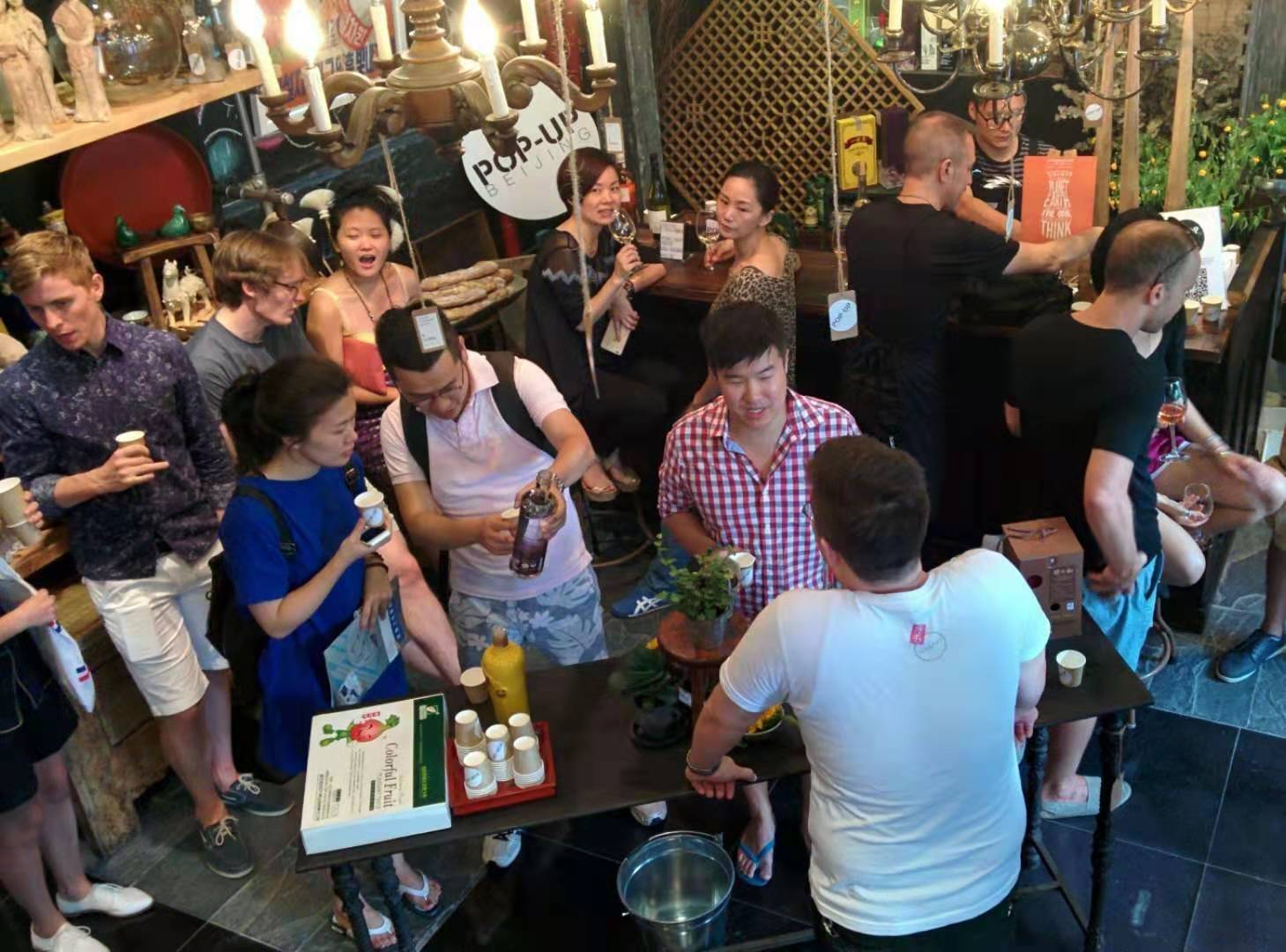 A WBD pop-up in Beijing, circa 2015. Image via worldbaijiuday.com
A WBD pop-up in Beijing, circa 2015. Image via worldbaijiuday.com
WBD events are held from Bangkok to Buenos Aires by baijiu enthusiasts worldwide and have never been formally sponsored. “We’re never trying to get the most events. It’s more just doing it with fun people. We’re all like, let’s do something once a year because we’re all interested in the spirit,” says Boyce.
If there’s one name synonymous with the international baijiu industry, it’s Derek Sandhaus. He became somewhat of an expert on baijiu while living in China, proceeded to write two books on the subject and went on to co-found Ming River Baijiu in 2018.
We spoke with Sandhaus via Skype as he was finishing breakfast at his home in Washington DC. He curated an extensive knowledge of baijiu through the best method: drinking, and has experienced the spirit from its most elegant to its most pedestrian.
He recalls an early baijiu experience in Shanghai on New Year’s Eve in 2007. A group of expats found a bar that would host an all-you-can-drink party for a reasonable price. Upon arrival, they realized that the bar had replaced all the imported spirits one expects to find at a Shanghai bar with baijiu and not the kind you gift to your prospective father-in-law. “A total disaster,” is how Sandhaus described it as the high-test liquor sent the night spiraling out of control.
Sandhaus tells us, “Over the next several years, I would experience baijiu in its more natural habitat. As I became more involved in [other] business ventures in China, I would be invited out to lunches in nice Chinese restaurants where baijiu would be served with the food. I would go to weddings and things like that. [However,] I still didn’t have a great impression of baijiu until I started making an effort to figure out what it was that I was drinking.”
He compares it to any other broad category of Chinese staples like tea or noodles – the variety is as vast as the people of China. “A lot of people mistake limited experience for the vast complexity of distilled spirits that are made in China,” says Sandhaus.
“Think of baijiu as an equivalent term to ‘Western spirits’”
For those who tried baijiu and swore off it forever, he gives the following analogy. “Think of baijiu as an equivalent term to ‘Western spirits.’ China is as big as continental Europe and there is as much linguistic, culinary and ethnic diversity throughout the landmass as there is in Western Europe. If you have a rough night with gin, you don’t then say you aren’t going to drink any spirit made in Europe... You’re not going to throw out vodka and whiskey because you didn’t like one of the hundreds of different things you could try.”
After Sandhaus published Baijiu: The Essential Guide to Chinese Spirits, he promoted the drink and the book by hosting informative tastings for people interested in the spirit.
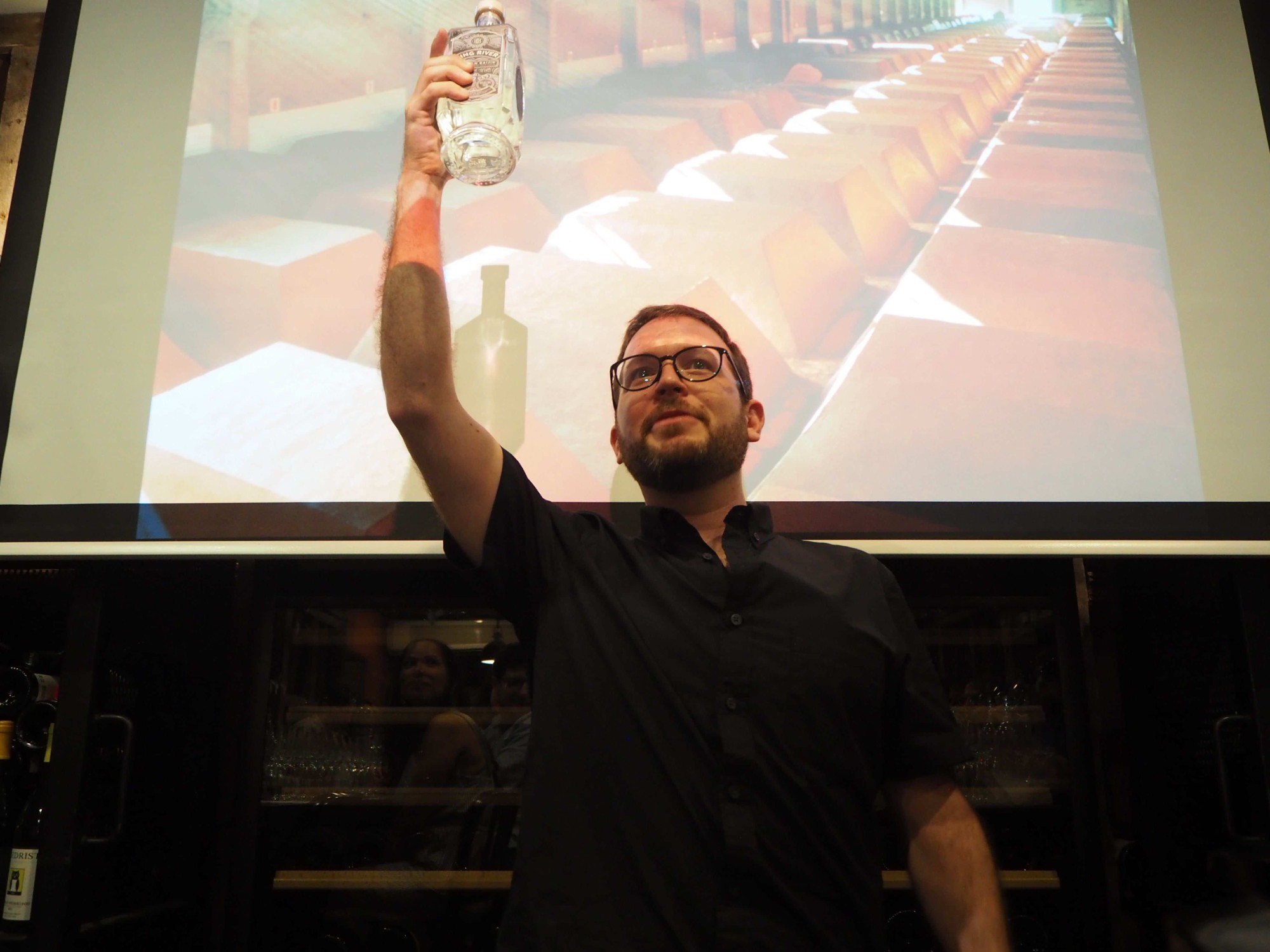
Derek Sandhaus educating the great unwashed about the beauty of baijiu. Image via Ming River Baijiu
At the Bookworm Literary Festival in Beijing, Sandhaus met Bill Isler. According to Sandhaus, “[Isler] said that he was really impressed with the talk and learning more about baijiu. But he was most impressed, after being in China a lot longer than me, that I had a room full of young Chinese and foreigners who were drinking and enjoying baijiu.” Isler suggested that baijiu be the theme for a new bar he and some friends were opening.
“It’s much easier to sell baijiu to people who have never tried it before”
Before long, baijiu distilleries around China began to send emissaries to investigate the phenomenon of expats and Chinese people frequenting a new neighborhood baijiu bar, Capital Spirits.
The concept had piqued the interest of China’s baijiu business. Requests to collaborate, replicate and proliferate baijiu in this new setting began rolling in. Sandhaus, Isler and a couple of friends set about starting a consultancy to internationalize baijiu.
The company was soon eclipsed by an offer from China’s oldest continuously operational distillery, Luzhou Laojiao. Despite boasting a fermentation pit from 1573, Luzhou Laojiao knew that they needed fresh perspectives to launch an international label. After two years of developing the product, Ming River Baijiu launched in 2018.
Unlike some Chinese distilleries that have released low alcohol, fruit-infused versions to appeal to younger drinkers, Ming River is an authentic and traditional strong aroma baijiu. Fast forward to 2021, and Ming River sells in 25 states across America, one province in Canada and several countries in Europe.
READ MORE: We Tried Peach and Apple Baijiu and It Tastes like Candy
Sandhaus says that misunderstanding is the biggest obstacle that baijiu faces internationally, and through education, he aims to enlighten the uninitiated masses.
He tells us, “It’s much easier to sell baijiu to people who have never tried it before than to people who were introduced to it in a more aggressive, ganbei binge drinking setting in China.”
Sandhaus’ second baijiu book, Drunk In China, provides a detailed account of his first-hand investigation of such sessions. “When you sit down with someone who hasn’t had baijiu before, you explain to them exactly what it is, how its made, what kind of flavors the distiller is trying to get in that product, and what the differences between different styles of baijiu are – and then you serve them a few of those different styles…it’s a much softer landing.”
READ MORE: Derek Sandhaus on Being Drunk in China
Surely baijiu will always have a home in China, but can it expand its scope to the bars in Lagos, London and Las Vegas?
It remains to be seen if baijiu will ever commonly be found on the shelf alongside vodka and tequila – spirits that have risen to global dominance. Maybe, baijiu is just too late, and the party’s already poppin’.
Nonetheless, the wheels are already in motion, and big baijiu certainly has the capital to reinvest. Such a diverse array of styles and flavors is sure to find a niche in the ever-evolving cocktail culture, at the very least.
[Cover image via Ming River Baijiu]
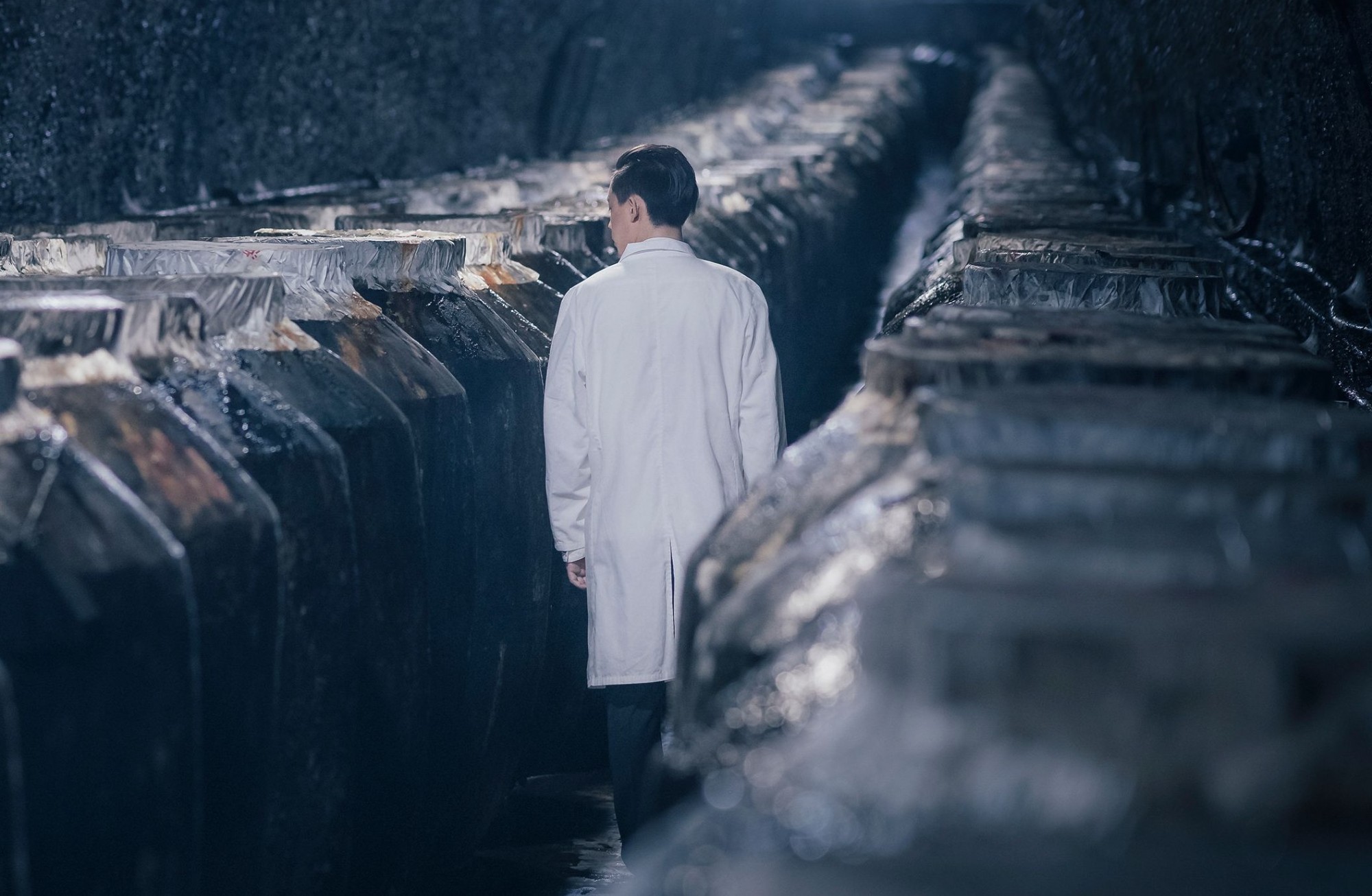






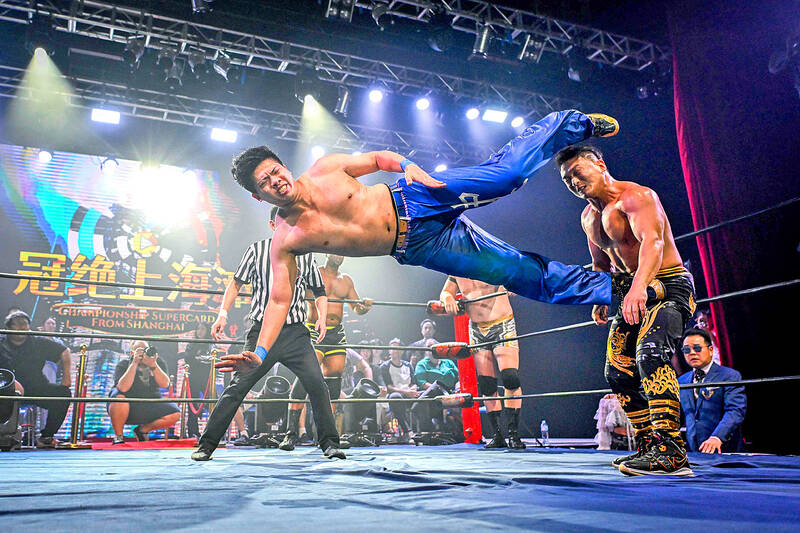













0 User Comments